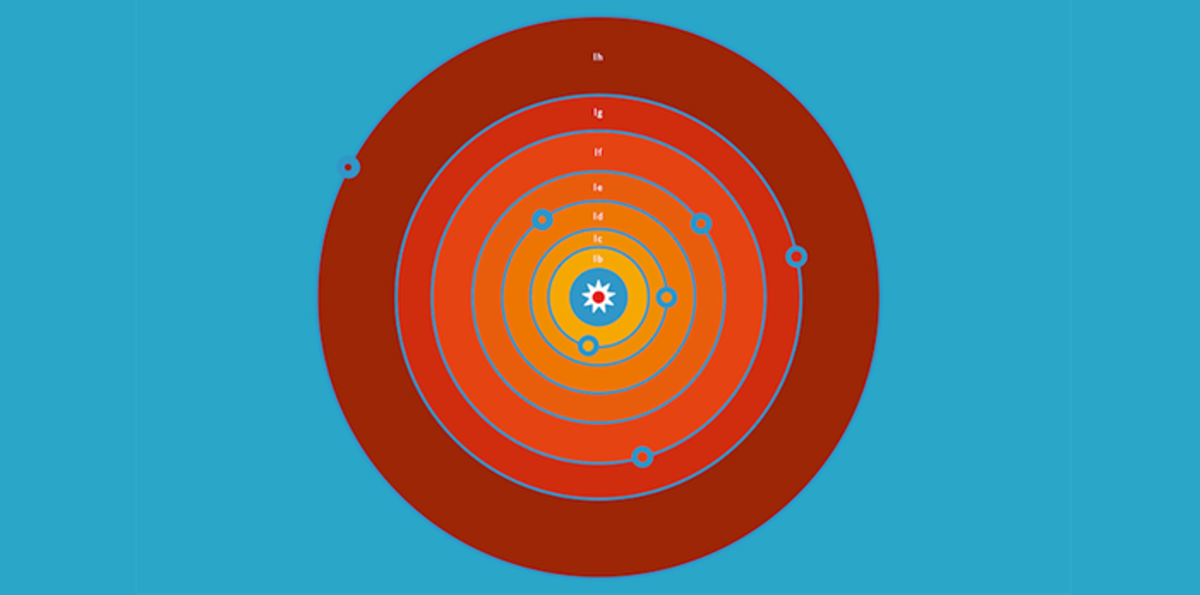PAOC Spotlights
Kepler Telescope Spies Details of TRAPPIST-1 System's Outermost Planet

A University of Washington-led international team of astronomers, among them Julien de Wit from PAOC in Department of Earth, Atmospheric and Planetary Sciences at MIT, has used data gathered by the Kepler Space Telescope to observe and confirm details of the outermost of seven exoplanets orbiting the star TRAPPIST-1.
Adapted from a story at University of Washington News
They confirmed that the planet, TRAPPIST-1h, orbits its star every 18.77 days, is linked in its orbital path to its siblings and is frigidly cold. Far from its host star, the planet is likely uninhabitable — but it may not always have been so.
UW doctoral student Rodrigo Luger is lead author on a paper published May 22 in the journal Nature Astronomy.
“TRAPPIST-1h was exactly where our team predicted it to be,” Luger said. The researchers discovered a mathematical pattern in the orbital periods of the inner six planets, which was strongly suggestive of an 18.77 day period for planet h.
“It had me worried for a while that we were seeing what we wanted to see. Things are almost never exactly as you expect in this field — there are usually surprises around every corner, but theory and observation matched perfectly in this case.”
TRAPPIST-1 is a middle-aged, ultra cool dwarf star, much less luminous than the sun and only a bit larger than the planet Jupiter. The star, which is nearly 40 light-years or about 235 trillion miles away in the constellation of Aquarius, is named after the ground-based Transiting Planets and Planetesimals Small Telescope (TRAPPIST), the facility that first found evidence of planets around it in 2015.
The TRAPPIST survey is led by Michael Gillon of the University of Liège, Belgium, who is also a coauthor on this research. In 2016, Gillon’s team announced the detection of three planets orbiting TRAPPIST-1 and this number was upped to seven in a subsequent 2017 paper. Three of TRAPPIST-1’s planets appear to be within the star’s habitable zone, that swath of space around a star where a rocky planet could have liquid water on its surface, thus giving life a chance.
Such exoplanets are detected when they transit, or pass in front of, their host star, blocking a measurable portion of the light. Gillon’s team was able to observe only a single transit for TRAPPIST-1h, the farthest-out of the star’s seven progeny, prior to the data analyzed by Luger’s team.
Luger led a multi-institution international research team that studied the TRAPPIST-1 system more closely using 79 days of observation data from K2, the second mission of the Kepler Space Telescope. The team was able to observe and study four transits of TRAPPIST-1h across its star.

The team used the K2 data to further characterize the orbits of the other six planets, help rule out the presence of additional transiting planets, and determine the rotation period and activity level of the star. They also discovered that TRAPPIST-1’s seven planets appear linked in a complex dance known as an orbital resonance where their respective orbital periods are mathematically related and slightly influence each other.
“Resonances can be tricky to understand, especially between three bodies. But there are simpler cases that are easier to explain,” Luger said. For instance, closer to home, Jupiter’s moons Io, Europa and Ganymede are set in a 1:2:4 resonance, meaning that Europa’s orbital period is exactly twice that of Io, and Ganymede’s is exactly twice that of Europa.
These relationships, Luger said, suggested that by studying the orbital velocities of its neighbor planets they could predict the exact orbital velocity, and hence also orbital period, of TRAPPIST-1h even before the K2 observations. Their theory proved correct when they located the planet in the K2 data.
TRAPPIST-1’s seven-planet chain of resonances established a record among known planetary systems, the previous holders being the systems Kepler-80 and Kepler-223, each with four resonant planets. The resonances are “self-correcting,” Luger said, such that if one planet were to somehow be nudged off course, it would lock right back into resonance. “Once you’re caught into this kind of stable resonance, it’s hard to escape,” he said.
All of this, Luger said, indicates that these orbital connections were forged early in the life of the TRAPPIST-1 system, when the planets and their orbits were not fully formed.
“The resonant structure is no coincidence, and points to an interesting dynamical history in which the planets likely migrated inward in lock-step,” Luger said. “This makes the system a great testbed for planet formation and migration theories.”
It also means that while TRAPPIST-1h is now extremely cold — with an average temperature of 173 Kelvin (minus 148 F) — it likely spent several hundred million years in a much warmer state, when its host star was younger and brighter.
“We could therefore be looking at a planet that was once habitable and has since frozen over, which is amazing to contemplate and great for follow-up studies,” Luger said.
Luger said he has been working with data from the K2 mission for a while now, researching ways to reduce “instrumental noise” in its data resulting from broken reaction wheels — small flywheels that help position the spacecraft — that can overwhelm planetary signals.
“Observing TRAPPIST-1 with K2 was an ambitious task,” said Marko Sestovic, a doctoral student at the University of Bern and second author of the study. In addition to the extraneous signals introduced by the spacecraft’s wobble, the faintness of the star in the optical (the range of wavelengths where K2 observes) placed TRAPPIST-1h “near the limit of what we could detect with K2,” he said. To make matters worse, Sestovic said, one transit of the planet coincided with a transit of TRAPPIST-1b, and one coincided with a stellar flare, adding to the difficulty of the observation. “Finding the planet was really encouraging,” Luger said, “since it showed we can still do high-quality science with Kepler despite significant instrumental challenges.”
Luger said the TRAPPIST-1 system’s relative nearness “makes it a prime target for follow-up and characterization with current and upcoming telescopes, which may be able to give us information about these planets’ atmospheric composition.”
Julien de Wit a postdoc in the Department of Earth, Atmospheric and Planetary Sciences (EAPS) at Massachusetts Institute of Technology contributed to this discovery as well as researchers at the University of Bern in Switzerland; Paris Diderot and Paris Sorbonne Universities and the CEA Saclay in France; the University of Liège in Belgium; the University of Chicago; the University of California, San Diego; California Institute of Technology; the University of Bordeaux in France; the University of Cambridge in England; NASA’s Ames Research Center, Goddard Space Flight Center, and Johnson Space Center; the University of Central Lancashire in England; King Abdulaziz University in Saudi Arabia; Cadi Ayyad University in Morocco; and the University of Geneva in Switzerland.
The research was funded by the NASA Astrobiology Institute via the UW-based Virtual Planetary Laboratory as well as a National Science Foundation Graduate Student Research Fellowship, the Swiss National Science Foundation, the Simons Foundation, the European Research Council and the UK Science and Technology Facilities Council, among other agencies.
For more information, visit www.trappist.one or contact Luger rodluger@uw.edu
Watch a video about the TRAPPIST-1 systems’s orbital resonances:
The animation shows a simulation of the planets of TRAPPIST-1 orbiting for 90 Earth-days. After 15 Earth days, the animation focuses only on the outer three planets: TRAPPIST-1f, TRAPPIST-1g, TRAPPIST-1h. The motion freezes each time two adjacent planets pass each other; an arrow appears pointing to the location of the third planet. This complex but predictable pattern, called an orbital resonance, occurs when planets exert a regular, periodic gravitational tug on each other as they orbit their star. The three-body resonance of the outer three planets causes the planets to repeat the same relative positions, and expecting such a resonance was used to predict the orbital period of TRAPPIST-1h. (Credit: Daniel Fabrycky / University of Chicago; with reference to Luger et al. 2017, Nature Astronomy)